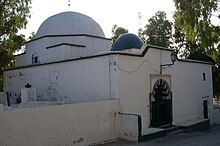| This article needs additional citations for verification. Please help improve this article by adding citations to reliable sources. Unsourced material may be challenged and removed. Find sources: "Madrasa El Bechiria" – news · newspapers · books · scholar · JSTOR (May 2016) (Learn how and when to remove this message) |

Madrasa El Bechiria (Arabic: المدرسة البشيرية) is one of the madrasahs of the medina of Tunis., which was constructed during the Husainid Dynasty and was attached to a zawiya.
Etymology
The madrasa is named after Sheikh Mohamed Al Bechir Al Zouaoui (Arabic: محمد البشير الزواوي), who was an important Rahmaniyya tariqa scholar, who died in Tunis in 1826.
Location

The madrasa is located on the Sidi El Bechir Street, in the southern suburb of the medina of Tunis.
History
The madrasa was dedicated to students from the Zouaoua tribe who followed the Rahmaniyya tariqa. It was built with a mausoleum in 1824 (1240 Hijri) by Al-Husayn II ibn Mahmud. It was managed by the son of Sheikh Al Bechir after his death.
Description
The madrasa contains seven rooms and a mosque.
Evolution
After the Tunisian independence, this madrasa was destroyed as part of restorations on Sidi El Bechir Street.
Students
Among students of this madarsa, we can find the historian Ahmad ibn Abi Diyaf who assisted tafsir classes (Quran explanations) taught by Al Bechir in person.
Bibliography
- Mohamed Belkhodja (1939). Tārīkh maʻālim al-tawḥīd fī al-qadīm wa-fī al-Jadīd (in Arabic). Tunis: al-Maṭbaʻah al-Tūnisīyah.
References
Category: